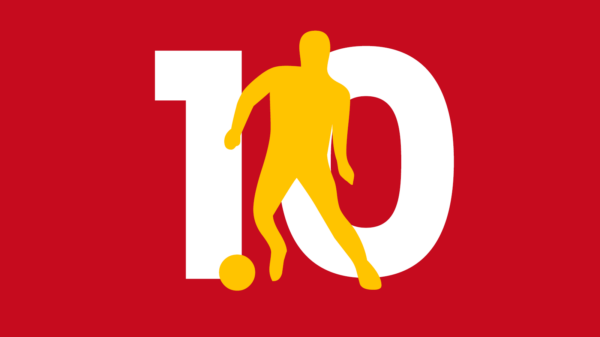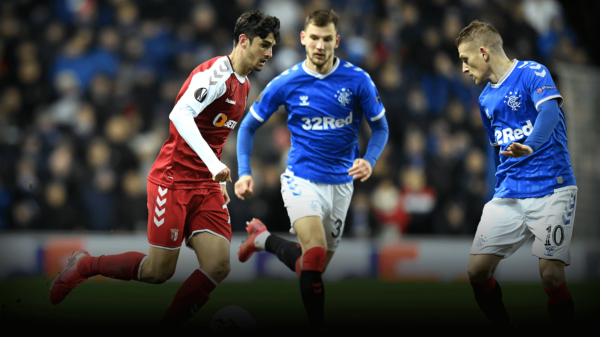The following is the second part of a mini-series in which Jake Askham takes a look at the common formations prevalent in football today. This piece focuses on the 4-3-3 formation.
Overview
The 4-3-3 formation is designed to both gain control of the central midfield whilst also allowing for variety in attack. It is common for one of the three midfielders to operate as a defensive midfielder whilst the two remaining midfielders have more responsibility in attack. The 3 attackers are often split into two wingers (LW and RW) and 1 striker; the wingers do have some defensive responsibility though and if they are ignored then it can cause plenty of problems when out of possession.
It should also be noted that the 4-3-2-1 is a variation of this formation; rather than playing with wingers they play with more central attacking midfielders who may drift into wide areas if the situation allows that to happen.
Furthermore, the 4-3-3 and 4-5-1 may look very similar on paper but in a game they are very different. Within the 4-5-1, the two full-backs rarely venture forward further than the half way line whilst in the 4-3-3 they have much more of an attacking license and are encouraged to overlap their corresponding full-back.
Strengths
The two main strengths are the control in midfield and the wingers playing high up the pitch.
One strength of this formation is that the midfield trio allows for them to control games and in many cases outnumber the opposition’s midfield. Most teams in modern football will have at least 1 midfielder whose primary role is to help the defenders to prevent the opposition scoring. One of the ways in which they can do that is by covering the full-backs as they push forward, filling the spaces between the central defenders and midfielders and even performing a man-marking job on the opposition’s number 10. The 4-3-3 (or 4-3-2-1) allows for a dedicated defensive midfielder and his role is pivotal in this formation as it gives attacking freedom to both central midfielders, the two full-backs and means the two wingers have less defensive responsibility.
The front 3 have great responsibility for creating and scoring goals, in order to be successful they need to work in tandem to create spaces for one another with their movements in relation to one another pivotal. For example, when the left winger crosses the ball, the right winger should arrive at the back post at the correct time whilst the striker should know where the cross is likely to arrive. The strength here lies in numbers. The two wingers can stay high up the pitch, even when the opposition are attacking which means they can be effective on the counter-attack and it also prevents the opposition’s full-backs pushing too far forward thus limiting the opposition’s attacking options.
General Weaknesses
One weakness that could be exploited in this formation is in the wide areas. The two wingers will often be pushed fairly high up in the pitch; which may lead to the two full-backs becoming isolated against the opposition’s attackers. This will bring one of the two central midfielders out of poisition in order to help prevent dangerous attacks in the wide areas, which then means the team loses its shape in the central areas. In order to counteract this, teams will shift to the side the attack is coming from which will result in the opposite side of the pitch being left wide open which can also be exploited.
Another issue with this formation is due to the importance of the full-backs pushing forward, it leaves only the two centre-backs and a defensive midfielder to cover the defense. Therefore, this means that the formation is very attack minded and in games where the opposition are dominant in possession it will be hard for the team to gain control of the game which is due to the wingers being high up the pitch and the risk that occurs when the full-backs push up the pitch too.
Successful implementation in recent times
One of the most successful implementations of the 4-3-3 is FC Barcelona from their treble winning 2008-2009 season. The attacking trio of Messi, Henry and Eto’o is as dynamic, exciting and skillful as you are likely to see whilst Xavi, Iniesta and Yaya Toure had a brilliant combination of power, creativity and passing ability. Furthermore, with Carles Puyol and Gerard Pique in the heart of the defense and Eric Abidal and Dani Alves as the two full-backs it is hard to see any real weakness.
One reason this formation worked so well is that the front 3 weren’t limited to any position. They would interchange with one another; with the two wide players often drifting inside, the main striker would drop deep whilst they were supported by the two full-backs pushing so far forward they would often be inside the opposition’s defensive third and supplying crosses and through balls to those ahead of them.
Key Player Roles
Fullbacks: The full-backs role in this formation is vital in both a defensive and attacking sense. The wingers will provide little cover defensively, which may leave them isolated to the opposition’s attacks and therefore they need to be competent in their defensive abilities and must pick the right time to join an attack or hold their position. Barcelona’s Dani Alves was fantastic at this; his defensive ability was often deemed a weakness which is an easy statement to make when a full-back is so attacking minded. But even when he got caught too high up the pitch, his incredible pace allowed him to chase the winger back.
Defensive midfielder: The defensive midfielder’s primary role is to win possession and then start an attacking phase. Within this he needs to cover spaces in between the midfield and defense where the opposition’s number 10 would be likely to be operating whilst also being aware when the full-backs had pushed forward. In modern football, the defensive midfielder also has a role to play in starting attacks; Xabi Alonso’s ability to dictate games from this position is a great example of an expert in this role.
Box to Box Midfielder: The box-to-box midfielder has responsibility throughout the pitch. He is expected to score goals and create chances for team mates, whilst also helping in the defensive third. One requirement of this role are high fitness levels due to the amount of running they are expected to do. The box-to-box midfielder is more likely to be found on the side of the pitch where the full-back that is less efficient in the attacking third plays to provide balance on both flanks. During his prime; Steven Gerrard would be a great example of a box-to-box midfielder as he possessed high fitness levels, great shooting and could tackle and defend when needed.
Playmaker: The playmaker’s main responsibility is to create chances for the three attackers in front of him. He will often find himself the furthest forward of the three midfielders and sometimes even in the number 10 role if the correct situation arises. The main requirement of the player in this role is creativity; they need to be able to play a pass that penetrates the opposition’s defense or dictates the direction of the attack. Andres Iniesta has played this role expertly for Barcelona for a number of years now; he can keep the ball as well as anyone else in world football and also has the creativity to fashion chances for those around him.
Conclusion
This formation would be suitable for a team who are looking to play an attacking brand of football with the wingers pushed high, the full-backs overlapping and the two midfielders looking to contribute to attacks. It would be very risky for a manager to use this formation in a game where the opposition are the favorites due to the risks on the counter-attack, although the front 3 could be utilized effectively against teams whose success is based on attacking full-backs as it would give the wingers space to exploit.
Further Reading:
Guide to the 4-1-2-1-2 formation
- Analysis: Harry Kane v Romelu Lukaku - June 8, 2017
- Tactical Principles: Half Spaces - September 7, 2016
- Tactical Principles: The Low Block - July 21, 2016



























































